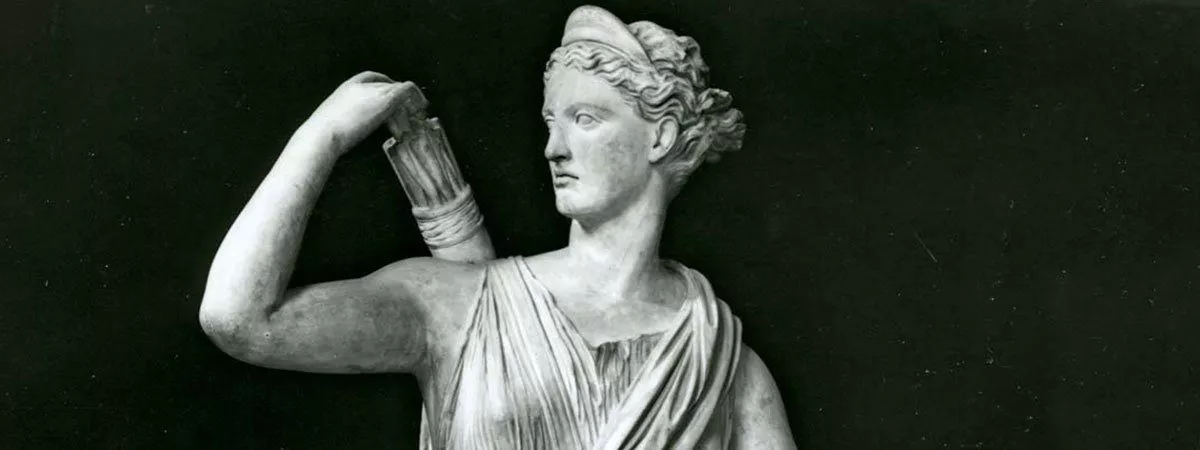Artemis was the Ancient Greek goddess of the hunt and the wilderness among other things. In Greek mythology, she was the daughter of Zeus and Leto. Just after her birth, she helped in the delivery of her twin brother Apollo due to which Artemis was also worshiped as the goddesses of childbirth and midwifery. Artemis was one of the three major Virgin Goddesses in Greek mythology; the others being Athena and Hestia. As Artemis was the goddess of the hunt, she is usually depicted with a bow and arrow. Moreover, there are several animals associated with her including deer, hunting dogs, boar and bear.
Artemis was one of the most widely venerated goddesses in Ancient Greece. There were several festivals held in her honor of which the Brauronia festival was most prominent. There was a temple in the Greek city of Ephesus which was solely dedicated to her and it was listed as one of the Seven Wonders of the Ancient World. Artemis continues to feature in popular culture and an asteroid belt has been named after her. Know more about the Ancient Greek Goddess Artemis through these 10 interesting facts.
#1 ARTEMIS WAS THE GODDESS OF THE HUNT AND THE WILDERNESS
In ancient Greek religion and myth, Artemis is the goddess of the hunt, the wilderness, wild animals, the moon and chastity. The word Artemis is often connected with the Persian word arta, which means “great, excellent and holy” and is interpreted as “great mother of nature”. This makes sense given Artemis’s status as the goddess of the hunt and the wilderness. Despite being a Virgin Goddess, Artemis was seen as a mother goddess and she was linked to fertility. She was also seen as the patron and protector of young girls with the power to bring disease upon women and relieve them of it. Moreover, she was petitioned to assist women with childbirth.
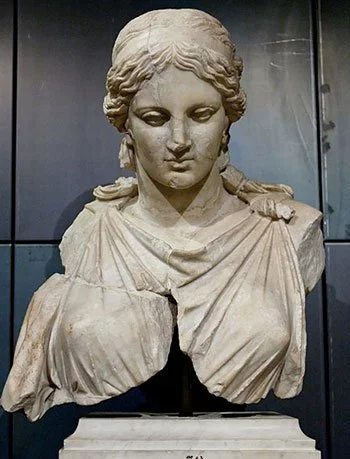
There are numerous symbols associated with Artemis. Being the goddess of the hunt, she carries a bow and arrow; rides a chariot pulled by four golden horned deer; and is sometimes also depicted with a hunting spear. As a goddess of maiden dances and songs, Artemis is often portrayed with a lyre. Animals associated with Artemis are deer, hunting dogs, bear, boar, Guinea fowl and Buzzard hawk. Plants sacred to Artemis are cypress and palm.
#2 SHE WAS ALSO ONE OF THE PRIMARY GODDESSES OF CHILDBIRTH AND MIDWIFERY
Artemis was the daughter of Zeus, king of the gods, and the Titaness Leto. Moreover, she was the twin sister of Apollo. When Hera, the sister-wife of Zeus discovered that Zeus had impregnated Leto, she cursed Leto not to find a solid ground or island on earth to give birth to her children. In labor and massive pain, Leto wandered all over Greece to find a place to give birth until she found Delos, a barren and floating island. According to myth, it was Zeus who emerged Delos from the sea so that Leto would find a place to bring forth her off springs Artemis and Apollo. The delivery of Artemis was painless but the birth of her younger twin brother Apollo was painful and treacherous because by then Hera had kidnapped Eileithyia, the goddess of childbirth. In the absence of Eileithyia, Artemis, having been born first, played the role of a midwife and assisted her mother with the birth of Apollo. It is due to this myth that Artemis was worshiped as one of the primary goddesses of childbirth and midwifery along with Eileithyia.

#3 SHE IS ONE OF THE TWELVE OLYMPIAN GODS
Artemis is one of the 12 Olympian Gods who resided atop Mount Olympus. The Olympians are a race of deities who are a third or fourth generation of immortal beings and they were worshiped as the principal deities of the Greek pantheon. The Olympians managed to become the supreme deities after a 10 year long struggle known as Titanomachy. In this struggle, Artemis’s father Zeus led his siblings to victory over the Titans who were the ruling deities at the time. Although there are a number of immortal residents at Mount Olympus, only 12 of them are considered the most important ones. These include the children of Titans Cronus and Rhea; namely Zeus, Hera, Poseidon, Demeter and Hestia; along with the main offspring of Zeus; namely Athena, Apollo, Artemis, Ares, Hephaestus, Hermes, Dionysus and Aphrodite. Being the daughter of Zeus, Artemis had a place of prominence among the 12 Olympian Gods.

#4 ARTEMIS WAS ONE OF THE THREE MAJOR VIRGIN GODDESSES
In Greek Mythology, the virgin goddesses or maiden goddesses do not marry or bear any children, the usual way or not at all. Artemis was one of the three major Virgin Goddesses in Greek mythology; the others being Athena and Hestia. A poem by ancient Greek poet Callimachus mentions how Artemis requested her father Zeus to grant her eternal virginity when she was just a young girl. Artemis’s virginity is not merely an observation of asexuality or chastity but also a symbol of her iron-like determination, pride, maturity, power and independence, equivalent to that of male gods.
Being a virgin, Artemis drew the attention and interest of many gods and men, but only her hunting companion, Orion, won her heart. It is to be noted that the concept of Artemis as a virgin deity is contradictory to her role as a goddess associated with childbirth. It is speculated that her virginity is related to her being a goddess of the hunt as hunters traditionally abstained from sex before a hunt. It might also be that her virginity was seen as a concentration of fertility that could be spread among her followers.
#5 DIANA IS THE ROMAN EQUIVALENT OF ARTEMIS
In Roman mythology, Diana is considered as the a goddess of the countryside, hunters, crossroads and the moon. She was also originally associated with wilderness and was a patroness of the hunters. She too was worshiped as a virgin goddess who was associated with fertility, childbirth and the protection of women during labor. According to the Roman poet Nemesianus, Diana carried a bow and a quiver full of golden arrows, typically clad in a short tunic and was accompanied by a deer. Roman mythology also says that Diana was the daughter of the Jupiter, the king of the Roman Gods; and his mistress, Latona. Moreover, she was born on the island of Delos along with her twin brother, Apollo. As Greek influence had a profound impact on Roman religion and Diana possessed many similar attributes of Artemis, she was fully conflated with the Artemis by the 3rd century CE.
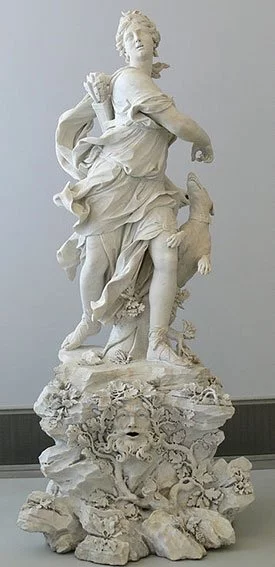
#6 THE CERYNEIAN HIND WAS SACRED TO ARTEMIS
In Greek mythology, a huge female deer known as the Ceryneian Hind always accompanied Artemis. Although female, it had male-like antlers which were shiny and golden; and hooves made of bronze or brass. The Ceryneian Hind is also often referred to as the Golden Hind because of its golden antlers. Based on various Greek tales, the creature had the ability to outrun a flying arrow. The Golden Hind was considered sacred and was used as a symbol to represent the sanctity of Artemis.
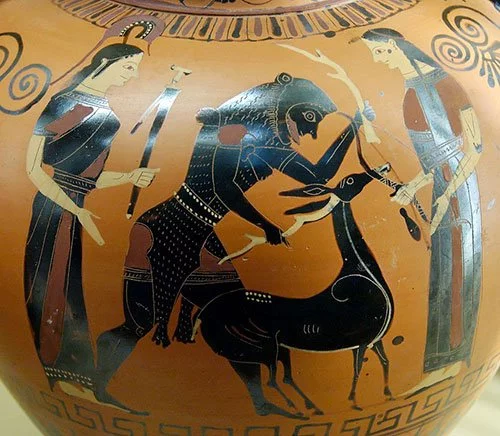
According to mythology, on seeing a deer larger than a bull with horns shining, Artemis fell in love with the creature and held them sacred. She was believed to have captured five Golden Hinds. She harnessed four of them to her chariot while the fifth one escorted her everywhere. Apart from its association with Artemis, the Ceryneian Hind is also famous because its capture was one of the twelve labors of Hercules. In ancient Roman art, a deer was often depicted with the goddess Diana, the Roman equivalent of Artemis.
#7 SHE IS DEPICTED IN ART AS A HUNTRESS WITH A BOW AND ARROW
Artemis is usually portrayed as a huntress with incredible beauty. She is most often shown with brown braided hair, pale skin and silvery eyes. Her eyes were compared to the light of the moon because of the presence of shimmer in them. In depictions in art, Artemis is usually shown as tall, slim and standing upright; draped in a knee-length chiton which is pinned at the shoulder; along with hunting boots. The length of her garment enables free movement and allows her to hunt conveniently. She is always shown carrying a quiver full of golden arrows and a silver bow, indicating her all-time readiness to unleash the inner huntress. Moreover her depictions usually include the animal and the plant that were sacred to her: the deer and the cypress. Artemis’s expression is often perceived as fierce and full of pride.
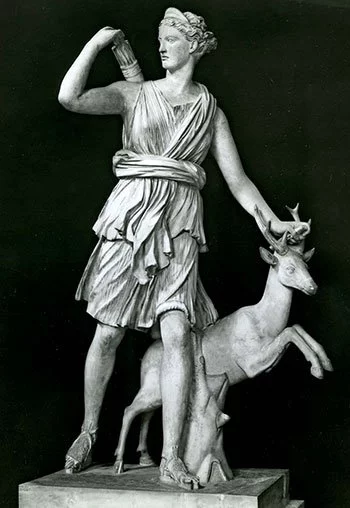
8 TEMPLE OF ARTEMIS WAS ONE OF THE SEVEN WONDERS OF THE ANCIENT WORLD
Artemis was one of the most widely venerated goddesses in Ancient Greece. She was identified with the many-breasted Lady of Ephesus and their was a temple solely dedicated to her which was located near the Greek city of Ephesus. The Temple of Artemis, also known as Artemision, was rebuilt twice and in its final form it was regarded as one of the Seven Wonders of the Ancient World. The earliest version of the temple dates back to the Bronze Age. In 7th century BCE, a flood destroyed the temple but it was reconstructed with more grandeur in 550 BCE. Its reconstruction took around 10 years.
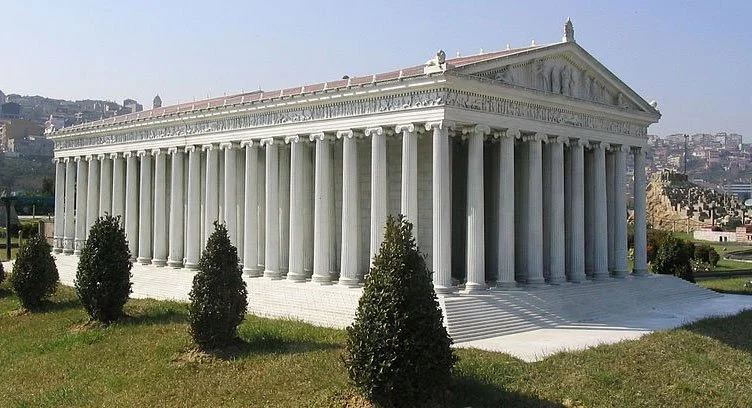
The temple was again destroyed in 356 BC. This time it was done by Herostratus, whose name became synonymous for someone who commits a criminal act in order to become famous. Its second reconstruction began in 323 BCE and continued for many years. It is this version of the temple which was listed in Antipater of Sidon’s list of world’s Seven Wonders. The closure of the Temple of Artemis is assumed to have occurred sometime during early to mid 5th century CE. Its site was rediscovered in 1869 in an excavation sponsored by the British Museum. Today, only foundations and fragments of the temple remain at the site.
#9 BRAURONIA FESTIVAL WAS HELD TO HONOR ARTEMIS
There were several festivals held in honor of Artemis in Ancient Greece including Elaphebolia, Mounikhia and Brauronia. Elaphebolia was held at Athens and Phocis; and was dedicated to Artemis Elaphebolos (deer slayer). Mounichia was held in Athens on the 16th (full moon time) of the month of Mounichion (spring) of Athenian calendar. The most important festival associated with Artemis was however Brauronia, which was held at the city of Brauron in Attica. Initially Brauronia was celebrated every 4 years but later it went to become an annual event. The festival consisted primarily of adolescent girls, aged between five and ten, who were sent to the sanctuary of Artemis at Brauron to serve the Goddess for one year.
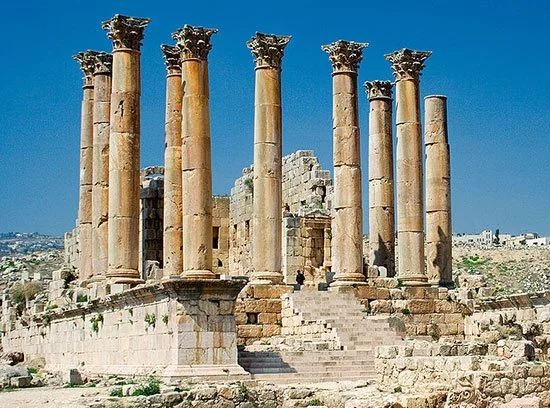
According to Greek mythology, a bear used to regularly visit the town of Brauron and ended up killing a girl on being teased. Thereafter, the girl’s brothers killed the bear and this enraged Artemis. The Greek goddess demanded young girls to “act the bear” in order to appease her to make amends for the bear’s death. Thus, during the period of servitude, the young girls were known as little she-bears and wore saffron robes to symbolize the skin of bears. Participants also performed a dance called arkteia to honor the goddess which primarily consisted of slow and solemn steps meant to imitate the movements of a bear.
#10 AN ASTEROID BELT IS NAMED AFTER HER
Artemis frequently featured in classical Greek art on paintings and statues. The goddess continues to appear in popular culture as a pioneer of environmental education and protector of wildlife. As Artemis was identified with the wildlife, many of her devoted religious sites were designated as sanctuaries and refuges where the hunting or killing of wild animals was prohibited. She featured in the Disney’s popular television series Hercules in an episode called Hercules and the Caledonian Boar. In it, she is portrayed as a goddess who appoints Hercules as a protector of the Caledonian Boars after being impressed by his mercy towards the boars.
On September 16, 1868, a Canadian-American astronomer named James Craig Watson discovered a main-belt asteroid and named it after Artemis. An ongoing crewed spaceflight program is being carried out predominately by NASA, the European Space Agency (ESA) and the Japan Aerospace Exploration Agency (JAXA) with the goal of landing “the first woman and the next man” on the moon at the lunar south pole region by 2024. This crewed spaceflight program is named after Artemis, the goddess of the moon.

